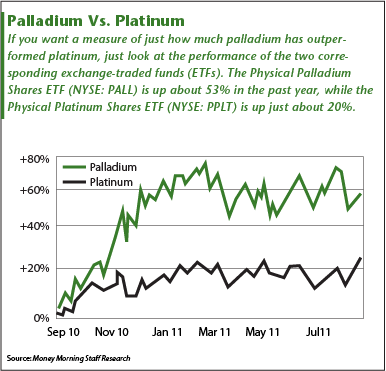Take palladium for instance.
Indeed, while platinum may have the prestige, palladium has the profits.
Palladium has seriously outperformed its sister metal over the past year: Its price has soared 57%, compared to a mere 23% increase in platinum prices.
Platinum is still trading 24% below its 10-year high, which was set at $2,273 an ounce in early 2008. But palladium just this past February established its own 10-year peak at $858 an ounce—and at about $743 per ounce now, it's just 15% shy of that mark. And that's despite the massive sell-off we've seen in precious metals over the past few days.
Furthermore, the outlook for palladium—from both fundamental and technical aspects—is decidedly positive. All that's left is for palladium to take out the $858 an ounce target it set earlier this year. Once that happens we could be looking at a blue-sky breakout for the unsung metal.
So let's take a closer look.
Fundamental Factors
Emerging market demand, a weak dollar, and a relative dearth of safe-haven investments have been a boon for commodities prices across the board. But palladium, unlike other precious metals, has the added bonus of industrial demand.
Some 63% of palladium is used in automobile catalysts, while only 6% makes its way into jewelry.
According to Scotiabank's recent Global Auto Report, car sales in the world's largest emerging markets—China, India, Brazil and Russia—are on pace to set new records this year. Even U.S. and Canadian sales are advancing at a healthy clip.
Remember, Fatih Birol, chief economist for the International Energy Agency (IEA), says that 700 out of every 1,000 people in the United States and 500 out of every 1,000 in Europe own cars today. But in China, only 30 out of 1,000 own cars. And Birol thinks that figure could jump to 240 out of every 1,000 by 2035.
That's a clear benefit to palladium demand.
In fact, this increasing demand has already led to a sharp decrease in palladium supplies.
Over the last five years, palladium was in net supply of nearly 1 million ounces, according to SFA Oxford, a consultancy that specializes in the platinum group of metals (PGM). But just last year that sharply reversed, with a net shortage of 210,000 ounces.
For now, shortages are filled through recycling and stockpiles of the metal.
Yet as SFA Oxford's projections show, except for this year, a deepening shortage of palladium is on tap as far as the next decade.
Part of the problem lies in South Africa. South Africa is responsible for 57% of the world's PGM production, but many of the country's miners are on strike following the government's decision to nationalize the mining sector.
The South African government's mining charter calls for 26% of the mining industry in Africa's largest economy to be transferred to African owners by 2014 as part an empowerment drive to rectify the disparities of white apartheid rule.
Africans owned just 8.9% of South Africa's mines in 2009, below a target of 15%.
Even if the targets are never met, just the ongoing threat is enough to frighten off potential investments in both new and existing projects, leading to lower total output.
The world's second-biggest PGM producer is Russia. That nation, too, is a wildcard. It's widely regarded as having huge stockpiles of these precious metals, but no one knows with any certainty how much of a cache remains. Some estimate that, after decades of drawdowns, what's left of the Russian stockpile will only satisfy the palladium production deficit until the end of 2012.
 Technically Speaking
Technically Speaking
On a technical basis, palladium is showing signs of consistent strength as well.
If you want to see just how well palladium has performed compared to platinum, just look at the performance of the two corresponding exchange-traded funds (ETFs). The Physical Palladium Shares ETF (NYSE: PALL) is up about 53% in the past year, while the Physical Platinum Shares ETF (NYSE: PPLT) is up just about 20%
As part of the same metal family, platinum and palladium are to some extent interchangeable in certain applications. So it's interesting to watch how their price ratio behaves.
With platinum's bull-run high only 15% away from where it's currently trading, the metal's price could easily hit that $858 an ounce target and keep soaring from there.
The simplest way to profit is through the Palladium Shares ETF (NYSE: PALL), which trades in reasonable volumes with an expense ratio under 1%.
I recommend you keep palladium on your precious metals watch list.



























































